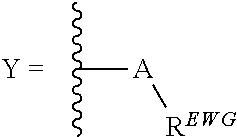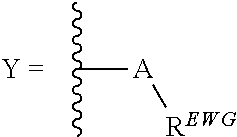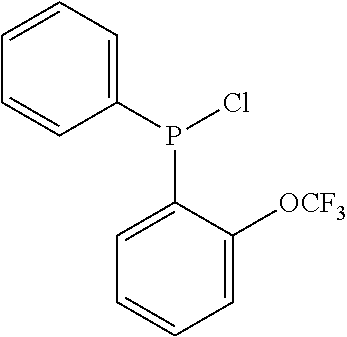Oligomerisation of ethylene to mixtures of 1-hexene and 1-octene
- Summary
- Abstract
- Description
- Claims
- Application Information
AI Technical Summary
Benefits of technology
Problems solved by technology
Method used
Image
Examples
example 1
Ethylene Tetramerisation with (2-[Trifluoromethoxy]Phenyl)(Phenyl)PN(iPr)P(Phenyl)2 at 60° C. and 45 Bar
[0221]A 600 ml stainless steel reactor was heated to 1200° C. for 30 minutes under vacuum, backfilled with N2 and then cooled to 60° C. The reactor was charged with 2,2,4-trimethylpentane (TMP) (100 ml), and heated to 60° C. Separately, MMAO-3A (2.4 mmol Al) was added to a mixture of Cr(acac)3 (2.5 μmol) and (2-[trifluoromethoxy]phenyl)(phenyl)PN(iPr)P(phenyl)2 (2.5 μmol) in methylcyclohexane (5 ml). This mixture was then transferred to the reactor. The reactor was pressurised with ethylene (45 bar), and stirred (1300 r.p.m.) with a gas entraining stirrer. The temperature in the reactor increased to 62-65° C., at which point the reactor was cooled by means of an internal cooling coil to maintain a constant temperature of 60° C. throughout the run. The reaction pressure was kept constant throughout the run by feeding ethylene on demand, and the consumption of ethylene was monitored...
example 2
Ethylene Tetramerisation with (2-[Trifluoromethoxy]Phenyl)(Phenyl)PN(iPr)P(Phenyl)2 at 60° C. and 45 Bar
[0222]The procedure of example 1 was followed, except that 0.625 μmol Cr(acac)3, 0.625 μmol (2-[trifluoromethoxy]phenyl)(phenyl)PN(iPr)P(phenyl)2 and 0.6 mmol Al in MMAO-3A was used, and the reaction was terminated after 16 minutes and 160 g total ethylene uptake.
example 3
Ethylene Tetramerisation with (2-[Trifluoromethoxy]Phenyl)(Phenyl)PN (nBu)P(Phenyl) at 60° C. and 45 Bar
[0223]The procedure of example 1 was followed, except that 1.25 μmol Cr(acac)3, 1.25 μmol of the ligand (2-[trifluoromethoxy]phenyl)(phenyl)PN(nBu)P(phenyl)2 and 1.2 mmol Al in MMAO-3A was used, and the reaction was terminated after 30 minutes and 160 g total ethylene uptake.
PUM
 Login to view more
Login to view more Abstract
Description
Claims
Application Information
 Login to view more
Login to view more - R&D Engineer
- R&D Manager
- IP Professional
- Industry Leading Data Capabilities
- Powerful AI technology
- Patent DNA Extraction
Browse by: Latest US Patents, China's latest patents, Technical Efficacy Thesaurus, Application Domain, Technology Topic.
© 2024 PatSnap. All rights reserved.Legal|Privacy policy|Modern Slavery Act Transparency Statement|Sitemap



